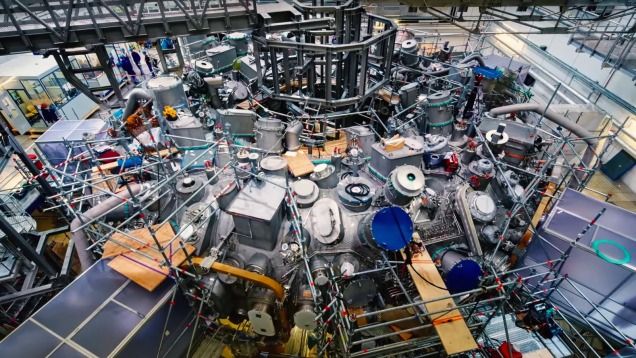If “The Stellarator” sounds like an energy source of comic book legend to you, you’re not that far off. It’s the largest nuclear fusion reactor in the world, and it’s set to turn on later this month.
Housed at the Max Planck Institute in Germany, the Wendelstein 7-X (W7-X) stellarator looks more like a psychotic giant’s art project than the future of energy. Especially when you compare it with the reactor’s symmetrical, donut-shaped cousin, the tokamak. But stellarators and tokamaks work according to similar principles: In both cases, coiled superconductors are used to create a powerful magnetic cage, which serves to contain a gas as it’s heated to the ungodly temperatures needed for hydrogen atoms to fuse.
Stellarators are ridiculously hard to build, a fact which should be self-evident after one glance at the W7-X. Its 16 meter-wide ring is bristling with devices and cables of all shapes and sizes, including 250 access ports. The guts of the beast are no less chaotic: Fifty 6-ton magnetic coils, twisted and contorted like clocks in a Dalí. By comparison, the tokamak is an engineer’s dream.

What about the thermal pollution ?
I wrote my doctoral thesis on the drift instability, which causes the plasma to escape and formulated the Generalized Fluid Description as the correct theoretical foundation for plasma physics to replace the kinetic theory, which is correct but unusable due to the difficulty in calculating field-charge consistency, and the magneto-fluid dynamics, which is incorrect because plasma is collisionless. Harold Grad endorsed my GFD over his own plasma fluid, but no one else could understand what we understood. I promptly vault pass science into post-science with a solution of value conceived in 1972. I congratulate the success of control fusion and will follow its progress with professional interest. With neutron economy, and radiation, the road to commercialization is still very long. Post-science will try to do an Infinite Spreadsheet calculation (http://infinitespreadsheet.com) to monitor its valuation based on realistic technical and financial projections. We welcome others to participate. Thank you. Hugh Ching http://hughching.com